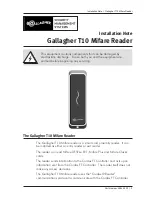
Glossary - 7
TCP/IP.
(Transmission Control Protocol/Internet Protocol) A communications protocol used to
internetwork dissimilar systems. This standard is the protocol of the Internet and has become
the global standard for communications.
TCP provides transport functions, which ensures that the total amount of bytes sent is
received correctly at the other end. UDP is an alternate transport that does not guarantee
delivery. It is widely used for real-time voice and video transmissions where erroneous
packets are not retransmitted.
IP provides the routing mechanism. TCP/IP is a routable protocol, which means that all
messages contain not only the address of the destination station, but the address of a
destination network. This allows TCP/IP messages to be sent to multiple networks within an
organization or around the world, hence its use in the worldwide Internet. Every client and
server in a TCP/IP network requires an IP address, which is either permanently assigned or
dynamically assigned at startup.
Telnet.
A terminal emulation protocol commonly used on the Internet and TCP/IP-based networks. It
allows a user at a terminal or computer to log onto a remote device and run a program.
TFTP.
(Trivial File Transfer Protocol) A version of the TCP/IP FTP (File Transfer Protocol) protocol
that has no directory or password capability. It is the protocol used for upgrading firmware,
downloading software and remote booting of diskless devices.
Tolerance.
Allowable deviation from the nominal bar or space width.
UDP.
(User Datagram Protocol) A protocol within the IP protocol suite that is used in place of TCP
when a reliable delivery is not required. For example, UDP is used for real-time audio and
video traffic where lost packets are simply ignored, because there is no time to retransmit. If
UDP is used and a reliable delivery is required, packet sequence checking and error
notification must be written into the applications.
UPC.
Universal Product Code. A relatively complex numeric symbology. Each character consists of
two bars and two spaces, each of which is any of four widths. The standard symbology for
retail food packages in the United States.
Visible Laser Diode
(VLD).
A solid state device which produces visible laser light.
WEP Encryption.
(Wired Equivalent Privacy encryption) The conversion of data into a secret code for
transmission over a public network. The original text, or plaintext, is converted into a coded
equivalent called ciphertext using an encryption algorithm. The ciphertext is decoded
(decrypted) at the receiving end and turned back into plaintext.
The encryption algorithm uses a key, which is a binary number that is typically from 40 to 128
bits in length. The greater the number of bits in the key (cipher strength), the more possible
key combinations and the longer it would take to break the code. The data is encrypted, or
“locked,” by combining the bits in the key mathematically with the data bits. At the receiving
end, the key is used to “unlock” the code and restore the original data.
Summary of Contents for MK1200
Page 1: ...MK1200 MicroKiosk for CE NET 4 2 Product Reference Guide ...
Page 2: ......
Page 3: ...MK1200 MicroKiosk for CE NET 4 2 Product Reference Guide 72E 87924 02 Revision A January 2008 ...
Page 6: ...iv MK1200 MicroKiosk for CE NET 4 2 Product Reference Guide ...
Page 13: ...Table of Contents xi Quick Startup Instructions ...
Page 14: ...xii MK1200 MicroKiosk for CE NET 4 2 Product Reference Guide ...
Page 18: ...xvi MK1200 MicroKiosk for CE NET 4 2 Product Reference Guide ...
Page 30: ...1 12 MK1200 MicroKiosk for CE NET 4 2 Product Reference Guide ...
Page 100: ...4 28 MK1200 MicroKiosk for CE NET 4 2 Product Reference Guide ...
Page 104: ...5 4 MK1200 MicroKiosk for CE NET 4 2 Product Reference Guide ...
Page 120: ...6 16 MK1200 MicroKiosk for CE NET 4 2 Product Reference Guide ...
Page 148: ...8 4 MK1200 MicroKiosk for CE NET 4 2 Product Reference Guide ...
Page 150: ...A 2 MK1200 MicroKiosk for CE NET 4 2 Product Reference Guide ...
Page 168: ...B 18 MK1200 MicroKiosk for CE NET 4 2 Product Reference Guide ...
Page 188: ...E 10 MK1200 MicroKiosk for CE NET 4 2 Product Reference Guide ...
Page 200: ...F 12 MK1200 MicroKiosk for CE NET 4 2 Product Reference Guide ...
Page 208: ...G 8 MK1200 MicroKiosk for CE NET 4 2 Product Reference Guide ...
Page 230: ......
Page 231: ......












































